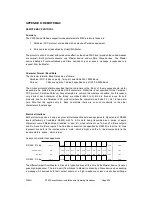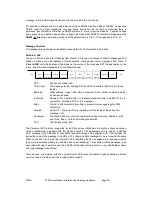
P300H P300 Series Modem Installation and Operating Handbook Page 186
ALARMS & AGC CONNECTOR
Connector type: 15 pin `D' male
ALARMS CONNECTOR
2, 12
Fault Relay - Common
4
Prompt Unit fault - N/O
11
Prompt Unit fault - N/C
3
Prompt Traffic fault (prompt) - N/O (c/o pair a)
10
Prompt Traffic fault (prompt) - N/C (c/o pair a)
5
Prompt Traffic fault (prompt) - N/O (c/o pair b)
13
Prompt Traffic fault (prompt) - N/C (c/o pair b)
1
Deferred alarm - N/O
9
Deferred alarm - N/C
6
Uncommitted analog output from processor (If Monitor/AGC option fitted).
Selectable Rx signal level, Eb/No, IF offset freq etc, see Appendix E
7
Transmit inhibit
8
Buffered direct AGC voltage. This may be used as an antenna-pointing signal
when the demod is unlocked. It responds to composite power in approximately
a 2MHz bandwidth around the nominal Rx carrier frequency.
14
Not connected
15
Ground
To externally inhibit the Transmit carrier, either apply a TTL/CMOS 'low' signal to pin 7, or short pin 7
to ground (for example with an external relay closure).
All relay contacts rated 30V DC 2A, or 125VAC 0.4A. The functions are as defined below:
Prompt Unit:
A
unit fault
exists, i.e. an equipment failure.
Prompt Traffic:
A Tx or Rx
traffic fault
exists.
Deferred alarm:
One of the following conditions exists:
The receive BER is greater than the user defined threshold.
The receive Eb/No is lower than the user defined threshold.
Buffer slips are more frequent than the user set threshold.
A Backward alarm is being received from either the satellite or
terrestrial ports.
Note:
N/O means 'normally open'
in the non-fail state of the modem
(relays energised), when power
is removed the relays fall back to the non-normal (ie non-energised) alarm state.
Note:
The function of these relays can be changed. See Relay Mode in Appendix E: Customer
Specific Features on page 207 for a description.
















































